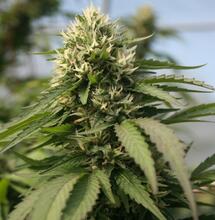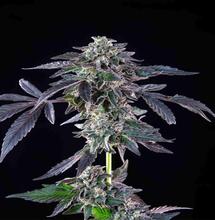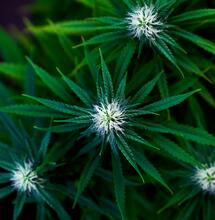Sexual Propagation
.jpg)
Sexual propagation is the process in which male and female sex cells (gametes) from separate parents unite in the female plant to form what will eventually mature into a new, genetically distinct individual. This process occurs when pollen from a male (staminate) parent unites with an ovule within the ovary of a female flower to create an embryo. This embryo, when mature and fully developed, will become a seed.
In nature, cannabis is wind-pollinated. Male flowers shed pollen (dehiscence), dispersing millions of grains into the wind. Wind carries the pollen to a “chance” rendezvous and acceptance by a female stigma. Pollination occurs when male pollen grains land on a female stigma. The evolutionary attraction is both physical and chemical. The grain of pollen, with moisture found in the stigma, germinates.
This is the best part: A grain of pollen germinates just like a seed, sending a taproot down, but instead of sending it into the ground, the grain of pollen sends the “root” down the stigma toward the ovary. Once united with the ovary, the pollen fertilizes the ovule. This union creates an embryo that grows within a seed coat. When mature in 4 to 6 weeks, the seed can be planted. Fertilization occurs when the tiny grain of male pollen sticks to the stigma.
Then it develops a tube through the style, and releases 2 gametes, 1 to fertilize the ovule and 1 to fertilize the endosperm (double fertilization). Seeds are the result of this sexual propagation and contain genetic characteristics of both parents. Once fertilized with male pollen, female plants put the bulk of their energy into producing strong, viable seeds. Actual fertilization takes place when the minute grain of male pollen sticks to the stigma.
The successful angiosperm pollen grain (gametophyte) containing the male gametes (sperm) gets transported to the stigma, where it germinates and its pollen tube grows down the style to the ovary. Its 2 gametes travel down the tube to where the gametophyte(s) containing the female gametes are held within the carpel. One nucleus fuses with the polar bodies to produce the endosperm tissues, and the other with the ovum to produce the embryo hence the term double fertilization.
Deoxyribonucleic acid (DNA) or “genetic material”* is coiled into long strands or chromosomes. The DNA is located inside the nucleus of each cell. When cannabis is pollinated, each individual seed inherits 10 different chromosomes from the male, and 10 different chromosomes from the seed mother—20 chromosomes total. Each seed has 2 copies of each of the 10 chromosomes, or 1 full genome each. There are 2 copies of every gene in the plant, 1 from the mother and 1 from the father. Every cell in the plant has a copy of this unique DNA.
The genetic code of this unique individual is embedded in a specific location along the length of the chromosome strands. Each seed contains genes from both parents. Progeny grown from seed usually have slightly different traits than other plants from the same seed lot. The same happens in humans; biological children are different from one another in many aspects and at the same time they resemble their parents. In cannabis, the variability is marked, like it is in apples. Sexual reproduction is used to cross different individuals with a population or family of plants. It can also be used to hybridize unrelated lines and inbreed their offspring.
This phenomenon, “recombination of traits,” also gives breeders the opportunity to recover individuals with a combination of the positive traits of both parental lines. • Genes are hereditary units that consist of a sequence of DNA that resides in a precise place on a chromosome and it determines a specific trait in cannabis. Little bits of DNA are codes or templates for proteins.* • Proteins are made in the sequence of DNA. Like instructions in a recipe for making brownies, the DNA and sequence of proteins is the recipe or instructions. • Having 2 versions of the same protein, from 2 different genes, is better than having just 1, particularly if the protein plays some vital part in cannabinoid production. This effect is called overdominance.
For example, if there are 2 different proteins, and both work well but 1 works a little better under hot conditions and the other works well under cool conditions. Having 2 versions of the same protein gives the plant a wider range of climates where it produces effectively. The majority of DNA is the same; it deals with basic cell processes, photosynthesis, chlorophyll production, etc. A few or a combination of genes control variables such as height, leaf shape, fragrance, and disease resistance. But we are not sure exactly which genes are responsible for specific traits, even though the cannabis genome has been mapped.
These traits are influenced by multigene families (a group of genes that evolved to become a little bit different from each other, even though they started out as copies of the same gene). Knowing the named genes would make it easier to find individual plants with your desired traits. But single genes controlling specific traits of cannabis are neither isolated nor well studied.
Multigene traits allow you to fi ne-tune to your favorite characteristics. For example, a single gene that controls leaf size would give only 2 leaf sizes, large and small. Many genes influencing the same trait provide many different leaf sizes. Naturally occurring mutated cannabis genes are uncommon. They are abnormal genes that are mutations of normal genes. When a mutated gene combines with a normal gene, there is no detrimental outcome. But when 2 mutated genes join, the result is much different.
For example, in people and animals the number of albinos or dwarfs is minimal. The same is true in cannabis. Growing large populations of cannabis or treating cannabis with stress or chemicals will bring about mutation. Overall, most cannabis plants grow normally with no mutations whatsoever. Many different genes control the desirable traits we care about. Broken recessive genes do not play a role in most breeding programs. Deleterious recessive genes: The plants most likely to have the same dangerous mutation in the immediate family are inbred. Marry your sister and inbreeding genes take over to start all kinds of problems because recessive deleterious genes appear.
By: Jorge Cervantes



